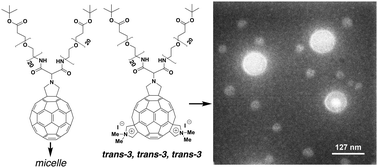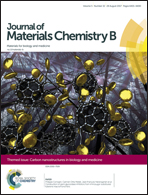Micelle vs. vesicle formation controlled by distal functionalization of C60–PEG conjugates†
Abstract
An amphiphilic C60–PEG conjugate was modified by the addition of cationic moieties in the hydrophobic C60 part to provide the related bis- and tris-adducts and their self-assembling structures were compared. All of these materials were water-soluble and their supramolecular structures were investigated in the aqueous phase using tensiometry, DLS, and STEM techniques. While mono- and bis-adducts formed micelle-type supramolecular structures, the tris-one with two additional cationic pyrrolidine groups showed the formation of larger particles as indicated by DLS data. Further, the STEM image of the tris-adduct showed a vesicle-type supramolecular structure with, presumably, an internal water-phase inside.

- This article is part of the themed collection: Carbon Nanostructures in Biology and Medicine


 Please wait while we load your content...
Please wait while we load your content...